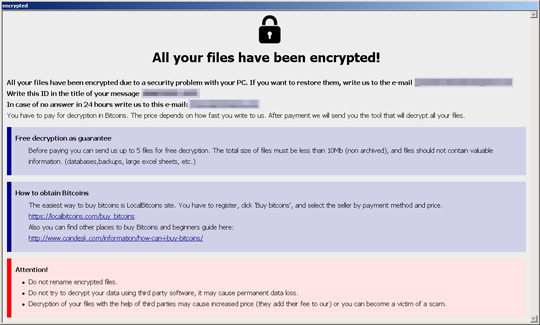Ransom.Win32.CRYSIS.APHW
Windows


Threat Type: Ransomware
Destructiveness: No
Encrypted: No
In the wild: Yes
OVERVIEW
Dropped by other malware, Downloaded from the Internet
This Ransomware arrives on a system as a file dropped by other malware or as a file downloaded unknowingly by users when visiting malicious sites.
It drops files as ransom note.
TECHNICAL DETAILS
52,224 bytes
EXE
Yes
24 Jul 2019
Terminates processes, Displays message/message boxes, Encrypts files
Arrival Details
This Ransomware arrives on a system as a file dropped by other malware or as a file downloaded unknowingly by users when visiting malicious sites.
Installation
This Ransomware drops the following copies of itself into the affected system:
- %System%\{Malware Filename}.exe ← (if admin)
- %Application Data%\{Malware Filename}.exe ← (if non-admin)
(Note: %System% is the Windows system folder, where it usually is C:\Windows\System32 on all Windows operating system versions.. %Application Data% is the current user's Application Data folder, which is usually C:\Documents and Settings\{user name}\Application Data on Windows 2000(32-bit), XP, and Server 2003(32-bit), or C:\Users\{user name}\AppData\Roaming on Windows Vista, 7, 8, 8.1, 2008(64-bit), 2012(64-bit) and 10(64-bit).)
It adds the following mutexes to ensure that only one of its copies runs at any one time:
- Global\<
>{8 Characters}00000000 - if running as non-admin - Global\<
>{8 Characters}00000001 - if running as admin
Autostart Technique
This Ransomware adds the following registry entries to enable its automatic execution at every system startup:
HKEY_LOCAL_MACHINE\Software\Microsoft\
Windows\CurrentVersion\Run
{Malware Filename} = "%System%\{Malware Filename}"
HKEY_LOCAL_MACHINE\Software\Microsoft\
Windows\CurrentVersion\Run
{Malware Filename} = "%Application Data%\{Malware Filename}"
HKEY_CURRENT_USER\Software\Microsoft\
Windows\CurrentVersion\Run
{Malware Filename} = "%Application Data%\{Malware Filename}"
It enables its automatic execution at every system startup by dropping the following copies of itself into the Windows Common Startup folder:
- %User Startup%\{Malware Filename}.exe
(Note: %User Startup% is the current user's Startup folder, which is usually C:\Windows\Profiles\{user name}\Start Menu\Programs\Startup on Windows 98 and ME, C:\WINNT\Profiles\{user name}\Start Menu\Programs\Startup on Windows NT, C:\Documents and Settings\{User name}\Start Menu\Programs\Startup on Windows 2003(32-bit), XP and 2000(32-bit), or C:\Users\{user name}\AppData\Roaming\Microsoft\Windows\Start Menu\Programs\Startup on Windows Vista, 7, 8, 8.1, 2008(64-bit), 2012(64-bit), 10(64-bit).)
Other System Modifications
This Ransomware adds the following registry entries:
HKEY_LOCAL_MACHINE\SOFTWARE\Microsoft\
CurrentVersion\Run
%System%\Info.hta = "mshta.exe "%System%\Info.hta""
HKEY_LOCAL_MACHINE\SOFTWARE\Microsoft\
Windows\CurrentVersion\Run
%Application Data%\Info.hta = "mshta.exe "%Application Data%\Info.hta""
HKEY_CURRENT_USER\SOFTWARE\Microsoft\
Windows\CurrentVersion\Run
%Application Data%\Info.hta = "mshta.exe "%Application Data%\Info.hta""
Process Termination
This Ransomware terminates the following processes if found running in the affected system's memory:
- agntsvc.exe
- dbeng50.exe
- dbsnmp.exe
- encsvc.exe
- excel.exe
- firefoxconfig.exe
- infopath.exe
- isqlplussvc.exe
- msaccess.exe
- msftesql.exe
- mspub.exe
- mydesktopqos.exe
- mydesktopservice.exe
- mysqld-nt.exe
- mysqld-opt.exe
- mysqld.exe
- ocautoupds.exe
- ocomm.exe
- ocssd.exe
- onenote.exe
- oracle.exe
- outlook.exe
- powerpnt.exe
- sqbcoreservice.exe
- sqlagent.exe
- sqlbrowser.exe
- sqlservr.exe
- sqlwriter.exe
- steam.exe
- synctime.exe
- tbirdconfig.exe
- thebat.exe
- thebat64.exe
- thunderbird.exe
- visio.exe
- winword.exe
- wordpad.exe
- xfssvccon.exe
Ransomware Routine
This Ransomware appends the following extension to the file name of the encrypted files:
- .[{BLOCKED}nehouse@aol.com].help
It drops the following file(s) as ransom note:
- {encrypted drive letter}\info.txt
- %Desktop%\info.txt
- {encrypted drive letter}\info.hta

- %Desktop%\info.hta
It leaves text files that serve as ransom notes containing the following text:
SOLUTION
9.850
Step 1
Before doing any scans, Windows 7, Windows 8, Windows 8.1, and Windows 10 users must disable System Restore to allow full scanning of their computers.
Step 2
Note that not all files, folders, and registry keys and entries are installed on your computer during this malware's/spyware's/grayware's execution. This may be due to incomplete installation or other operating system conditions. If you do not find the same files/folders/registry information, please proceed to the next step.
Step 3
Restart in Safe Mode
Step 4
Delete this registry value
Important: Editing the Windows Registry incorrectly can lead to irreversible system malfunction. Please do this step only if you know how or you can ask assistance from your system administrator. Else, check this Microsoft article first before modifying your computer's registry.
- HKEY_LOCAL_MACHINE\Software\Microsoft\Windows\CurrentVersion\Run
- {Malware Filename} = "%System%\{Malware Filename}
- HKEY_LOCAL_MACHINE\Software\Microsoft\Windows\CurrentVersion\Run
- {Malware Filename} = "%Application Data%\{Malware Filename}
- HKEY_CURRENT_USER\Software\Microsoft\Windows\CurrentVersion\Run
- {Malware Filename} = "%Application Data%\{Malware Filename}
- HKEY_LOCAL_MACHINE\SOFTWARE\Microsoft\CurrentVersion\Run
- %System%\Info.hta = "mshta.exe "%System%\Info.hta""
- HKEY_LOCAL_MACHINE\SOFTWARE\Microsoft\Windows\CurrentVersion\Run
- %Application Data%\Info.hta = "mshta.exe "%Application Data%\Info.hta""
- HKEY_CURRENT_USER\SOFTWARE\Microsoft\Windows\CurrentVersion\Run
- %Application Data%\Info.hta = "mshta.exe "%Application Data%\Info.hta""
Step 5
Search and delete these files
- {encrypted drive letter}\info.txt
- %Desktop%\info.txt
- {encrypted drive letter}\info.hta
- %Desktop%\info.hta
Step 6
Restart in normal mode and scan your computer with your Trend Micro product for files detected as Ransom.Win32.CRYSIS.APHW. If the detected files have already been cleaned, deleted, or quarantined by your Trend Micro product, no further step is required. You may opt to simply delete the quarantined files. Please check this Knowledge Base page for more information.
Step 7
Restore encrypted files from backup.
Did this description help? Tell us how we did.


